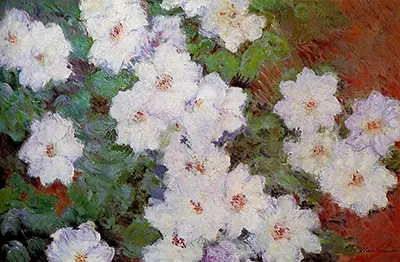Painted in 1897, "Clematis" reveals many of Monet's trademark impressionistic skills.
The very nature of "Impressionism" is to create an impression. A technique in order to create a feeling of spontaneity and an immediate response to a subject through a quickly executed painting, but never to the exclusion of masterly, brilliant brushstrokes.
Monet tended to use light coloured canvasses and a limited range of opaque colours (and occasionally green) which gives this particular painting a luminescent quality and an image looking as if steeped in Mediterranean sunshine. There is the sense almost of being able to look through the pale petals to the canvas beneath. In fact sometimes, areas were left bare to add an even greater luminosity to the subject.
Whilst the image of the Clematis isn't botanically correct to the last detail, Monet has captured the essence of the plant. The delicate petals looking almost frayed at the edges; the subtle colour tones of white, pink, mauve and in the centre, eye catching yellows and reds.
Monet adopted a continuously improvisational approach to his paintings, and there is a sense of his acting on the moment as he jots down in paint his visual impressions. In the painting you can observe how he marries cool colours against warm. The white Clematis against the green leaves and Terra Cotta background.
Using a large filbert tipped brush (a narrow flat brush that comes to a rounded point) the flowers are created using small deft brush strokes with no attempt at detail but merely to capture light. There is no attempt to create a clear delineation between the blooms and the foliage.
But in spite of this, the flowers seem to burst out from the bush. This effect is enhanced further by the way in which thicker impasto brush strokes for the leaves make the blooms seem even more prominent.
Another factor worthy of note is how Monet uses broken colour to achieve his effects.
In this way, colours are not deliberately mixed on the canvas, but are set next to one another so that the viewer can perceive a blend in their visual field. Looking at where some of the flowers intersect, touches of blue, violet and mauve whilst not what one would actually see in reality, give an entity to the subject matter drawing the spectator into the world Monet is trying to convey.
Finally, you can see how using layers of paint of varying thicknesses allow lower layers of colour to show through particularly where the russet coloured wall shows through the foliage.
Overall, the effect is of sunlit blooms being gently wafted in the breeze. The painting is full of radiance and movement.


